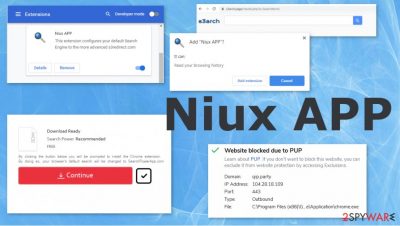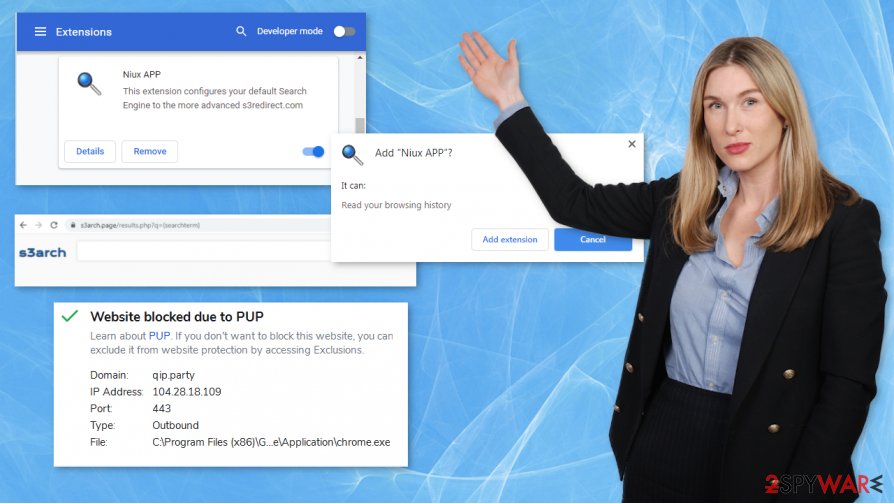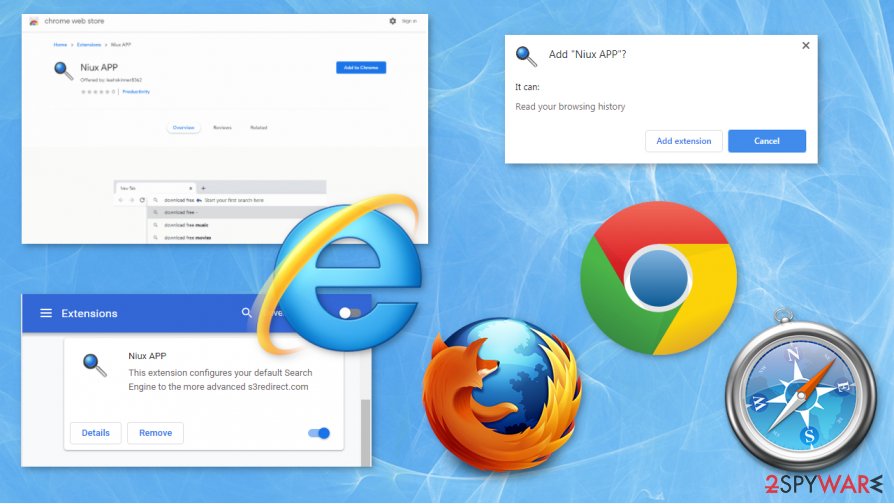Niux APP (Removal Guide) - Free Instructions
Niux APP Removal Guide
What is Niux APP?
Niux APP – the program that manages to alter preferences on web browsers to control the traffic

| Name | Niux APP |
|---|---|
| Type | Browser hijacker/ Potentially Unwanted Program |
| Issues | The application alters settings on the web browser, so each search goes through the wanted, in most cases sponsored, the engine that injects commercial material and redirects, pop-up ads on the list of search results |
| Distribution | The program gets promoted on various software distribution sites and platforms, so people can install the PUP themselves, but mainly it is injected on the Chrome browser by the threat actors who use deceptive methods and techniques like software bundling for the distribution of this hijacker |
| Elimination | Niux APP removal process can be difficult, but the automatic method with the help of AV tools can give the best results went he system gets fully checked and cleaned |
| Repair | The system gets altered behind the users back when the PUP changes functionality or affects files in the system. Check and fix those file corruption issues with FortectIntego |
Niux APP is considered a browser hijacker because it can alter the browser to achieve the needed goals of the PUP creator. It mainly focuses on the start page, homepage, default search engine alterations, so the initiated processes get rerouted to one of the associated sites.
The intruder triggers all the changes to ensure that the browser-based threat is persistently running on the machine. This is why it gets somewhat difficult to remove Niux APP. You can uninstall the browser extension, and hope that this is the solution for the problem of redirects, commercial content pop-ups and so on.
This is not the best nor the only way to perform Niux APP removal. If you delete the application, browser component, you cannot be sure that all the symptoms will end. The main PUP that affects machines from the background is hidden in the system folder or different parts of the computer.
When such Niux APP virus affects the performance, you have no other option but to visit sites that PUP developer chooses. Also, your screen gets filled with pop-ups, banners other unwanted material.[2] Make sure to clean the machine as soon as you notice suspicious behavior.

Niux APP as any other potentially unwanted program can interfere with the performance by injecting other tools and programs on the machine behind your back. You need to get rid of it as soon as possible, so you clear the machine and avoid damage that more severe malware might cause.
Anti-malware tools are the best tools that can help you to eliminate Niux APP and other PUPs, applications related to the save provider, developer, or commercial content creators. Run the security tool and clear all the indicated files and programs automatically. As for the possible alterations and damage that experts[3] talk about – rely on FortectIntego and fix issues yourself.

Rely on proper sources and official providers to avoid PUPs
You should already know that anything on the internet can pose risks and harm to your device, so make sure to choose reliable program developers, pay attention to sites you visit constantly. Choose official freeware providers, developers, and avoid pirating or torrent pages, platforms.
When you are not considering every site or program as possibly dangerous you risk getting the unwanted programs installed. This browser extension gets installed on purpose when people fall for the claims on promotional ads and think that the tool provides all the alleged functions. There is nothing valuable about the program, however.
You can avoid infection when you choose Advanced or Custom options during the installation, so you can see the full list of pre-bundled programs and deselect anything you do not need.
Get rid of the shady Niux APP virus with anti-malware tools
Even though we tend to accent that this is not a malicious program and it doesn't count as malware, there is the crucial thing about PUP distribution, alterations, and termination process. You need to remove Niux APP properly from the machine, and the best way to achieve that is the AV tool with an updated database.
The up-to-date information on threats, PUPs, malicious products is extremely important when you try to perform the proper Niux APP removal. When the AV tool detects this intruder or any associated files, program, or can clear all the traces and quickly, If you use the outdated tool or a free version it may not be that helpful, and PUP remains running.
You may remove virus damage with a help of FortectIntego. SpyHunter 5Combo Cleaner and Malwarebytes are recommended to detect potentially unwanted programs and viruses with all their files and registry entries that are related to them.
Getting rid of Niux APP. Follow these steps
Uninstall from Windows
Instructions for Windows 10/8 machines:
- Enter Control Panel into Windows search box and hit Enter or click on the search result.
- Under Programs, select Uninstall a program.

- From the list, find the entry of the suspicious program.
- Right-click on the application and select Uninstall.
- If User Account Control shows up, click Yes.
- Wait till uninstallation process is complete and click OK.

If you are Windows 7/XP user, proceed with the following instructions:
- Click on Windows Start > Control Panel located on the right pane (if you are Windows XP user, click on Add/Remove Programs).
- In Control Panel, select Programs > Uninstall a program.

- Pick the unwanted application by clicking on it once.
- At the top, click Uninstall/Change.
- In the confirmation prompt, pick Yes.
- Click OK once the removal process is finished.
Delete from macOS
Remove items from Applications folder:
- From the menu bar, select Go > Applications.
- In the Applications folder, look for all related entries.
- Click on the app and drag it to Trash (or right-click and pick Move to Trash)

To fully remove an unwanted app, you need to access Application Support, LaunchAgents, and LaunchDaemons folders and delete relevant files:
- Select Go > Go to Folder.
- Enter /Library/Application Support and click Go or press Enter.
- In the Application Support folder, look for any dubious entries and then delete them.
- Now enter /Library/LaunchAgents and /Library/LaunchDaemons folders the same way and terminate all the related .plist files.

Remove from Microsoft Edge
Delete unwanted extensions from MS Edge:
- Select Menu (three horizontal dots at the top-right of the browser window) and pick Extensions.
- From the list, pick the extension and click on the Gear icon.
- Click on Uninstall at the bottom.

Clear cookies and other browser data:
- Click on the Menu (three horizontal dots at the top-right of the browser window) and select Privacy & security.
- Under Clear browsing data, pick Choose what to clear.
- Select everything (apart from passwords, although you might want to include Media licenses as well, if applicable) and click on Clear.

Restore new tab and homepage settings:
- Click the menu icon and choose Settings.
- Then find On startup section.
- Click Disable if you found any suspicious domain.
Reset MS Edge if the above steps did not work:
- Press on Ctrl + Shift + Esc to open Task Manager.
- Click on More details arrow at the bottom of the window.
- Select Details tab.
- Now scroll down and locate every entry with Microsoft Edge name in it. Right-click on each of them and select End Task to stop MS Edge from running.

If this solution failed to help you, you need to use an advanced Edge reset method. Note that you need to backup your data before proceeding.
- Find the following folder on your computer: C:\\Users\\%username%\\AppData\\Local\\Packages\\Microsoft.MicrosoftEdge_8wekyb3d8bbwe.
- Press Ctrl + A on your keyboard to select all folders.
- Right-click on them and pick Delete

- Now right-click on the Start button and pick Windows PowerShell (Admin).
- When the new window opens, copy and paste the following command, and then press Enter:
Get-AppXPackage -AllUsers -Name Microsoft.MicrosoftEdge | Foreach {Add-AppxPackage -DisableDevelopmentMode -Register “$($_.InstallLocation)\\AppXManifest.xml” -Verbose

Instructions for Chromium-based Edge
Delete extensions from MS Edge (Chromium):
- Open Edge and click select Settings > Extensions.
- Delete unwanted extensions by clicking Remove.

Clear cache and site data:
- Click on Menu and go to Settings.
- Select Privacy, search and services.
- Under Clear browsing data, pick Choose what to clear.
- Under Time range, pick All time.
- Select Clear now.

Reset Chromium-based MS Edge:
- Click on Menu and select Settings.
- On the left side, pick Reset settings.
- Select Restore settings to their default values.
- Confirm with Reset.

Remove from Mozilla Firefox (FF)
Remove dangerous extensions:
- Open Mozilla Firefox browser and click on the Menu (three horizontal lines at the top-right of the window).
- Select Add-ons.
- In here, select unwanted plugin and click Remove.

Reset the homepage:
- Click three horizontal lines at the top right corner to open the menu.
- Choose Options.
- Under Home options, enter your preferred site that will open every time you newly open the Mozilla Firefox.
Clear cookies and site data:
- Click Menu and pick Settings.
- Go to Privacy & Security section.
- Scroll down to locate Cookies and Site Data.
- Click on Clear Data…
- Select Cookies and Site Data, as well as Cached Web Content and press Clear.

Reset Mozilla Firefox
If clearing the browser as explained above did not help, reset Mozilla Firefox:
- Open Mozilla Firefox browser and click the Menu.
- Go to Help and then choose Troubleshooting Information.

- Under Give Firefox a tune up section, click on Refresh Firefox…
- Once the pop-up shows up, confirm the action by pressing on Refresh Firefox.

Remove from Google Chrome
Delete malicious extensions from Google Chrome:
- Open Google Chrome, click on the Menu (three vertical dots at the top-right corner) and select More tools > Extensions.
- In the newly opened window, you will see all the installed extensions. Uninstall all the suspicious plugins that might be related to the unwanted program by clicking Remove.

Clear cache and web data from Chrome:
- Click on Menu and pick Settings.
- Under Privacy and security, select Clear browsing data.
- Select Browsing history, Cookies and other site data, as well as Cached images and files.
- Click Clear data.

Change your homepage:
- Click menu and choose Settings.
- Look for a suspicious site in the On startup section.
- Click on Open a specific or set of pages and click on three dots to find the Remove option.
Reset Google Chrome:
If the previous methods did not help you, reset Google Chrome to eliminate all the unwanted components:
- Click on Menu and select Settings.
- In the Settings, scroll down and click Advanced.
- Scroll down and locate Reset and clean up section.
- Now click Restore settings to their original defaults.
- Confirm with Reset settings.

Delete from Safari
Remove unwanted extensions from Safari:
- Click Safari > Preferences…
- In the new window, pick Extensions.
- Select the unwanted extension and select Uninstall.

Clear cookies and other website data from Safari:
- Click Safari > Clear History…
- From the drop-down menu under Clear, pick all history.
- Confirm with Clear History.

Reset Safari if the above-mentioned steps did not help you:
- Click Safari > Preferences…
- Go to Advanced tab.
- Tick the Show Develop menu in menu bar.
- From the menu bar, click Develop, and then select Empty Caches.

After uninstalling this potentially unwanted program (PUP) and fixing each of your web browsers, we recommend you to scan your PC system with a reputable anti-spyware. This will help you to get rid of Niux APP registry traces and will also identify related parasites or possible malware infections on your computer. For that you can use our top-rated malware remover: FortectIntego, SpyHunter 5Combo Cleaner or Malwarebytes.
How to prevent from getting browser hijacker
Choose a proper web browser and improve your safety with a VPN tool
Online spying has got momentum in recent years and people are getting more and more interested in how to protect their privacy online. One of the basic means to add a layer of security – choose the most private and secure web browser. Although web browsers can't grant full privacy protection and security, some of them are much better at sandboxing, HTTPS upgrading, active content blocking, tracking blocking, phishing protection, and similar privacy-oriented features. However, if you want true anonymity, we suggest you employ a powerful Private Internet Access VPN – it can encrypt all the traffic that comes and goes out of your computer, preventing tracking completely.
Lost your files? Use data recovery software
While some files located on any computer are replaceable or useless, others can be extremely valuable. Family photos, work documents, school projects – these are types of files that we don't want to lose. Unfortunately, there are many ways how unexpected data loss can occur: power cuts, Blue Screen of Death errors, hardware failures, crypto-malware attack, or even accidental deletion.
To ensure that all the files remain intact, you should prepare regular data backups. You can choose cloud-based or physical copies you could restore from later in case of a disaster. If your backups were lost as well or you never bothered to prepare any, Data Recovery Pro can be your only hope to retrieve your invaluable files.
- ^ What Is Browser Hijacking?. Kaspersky. Security insights.
- ^ Ad tracking. Wikipedia. The free encyclopedia.
- ^ Virusai. Virusai. Malware removal guides and security news.























